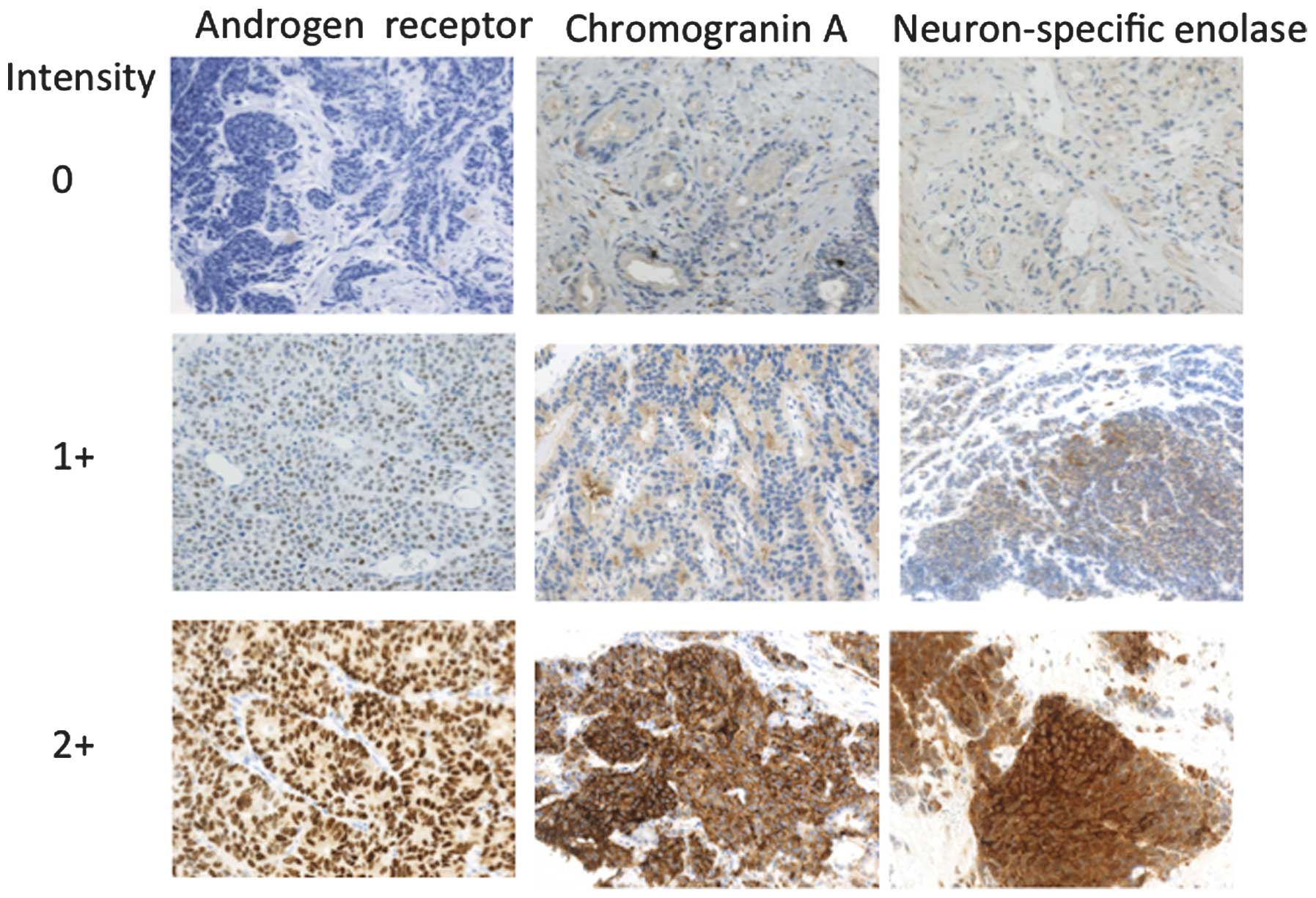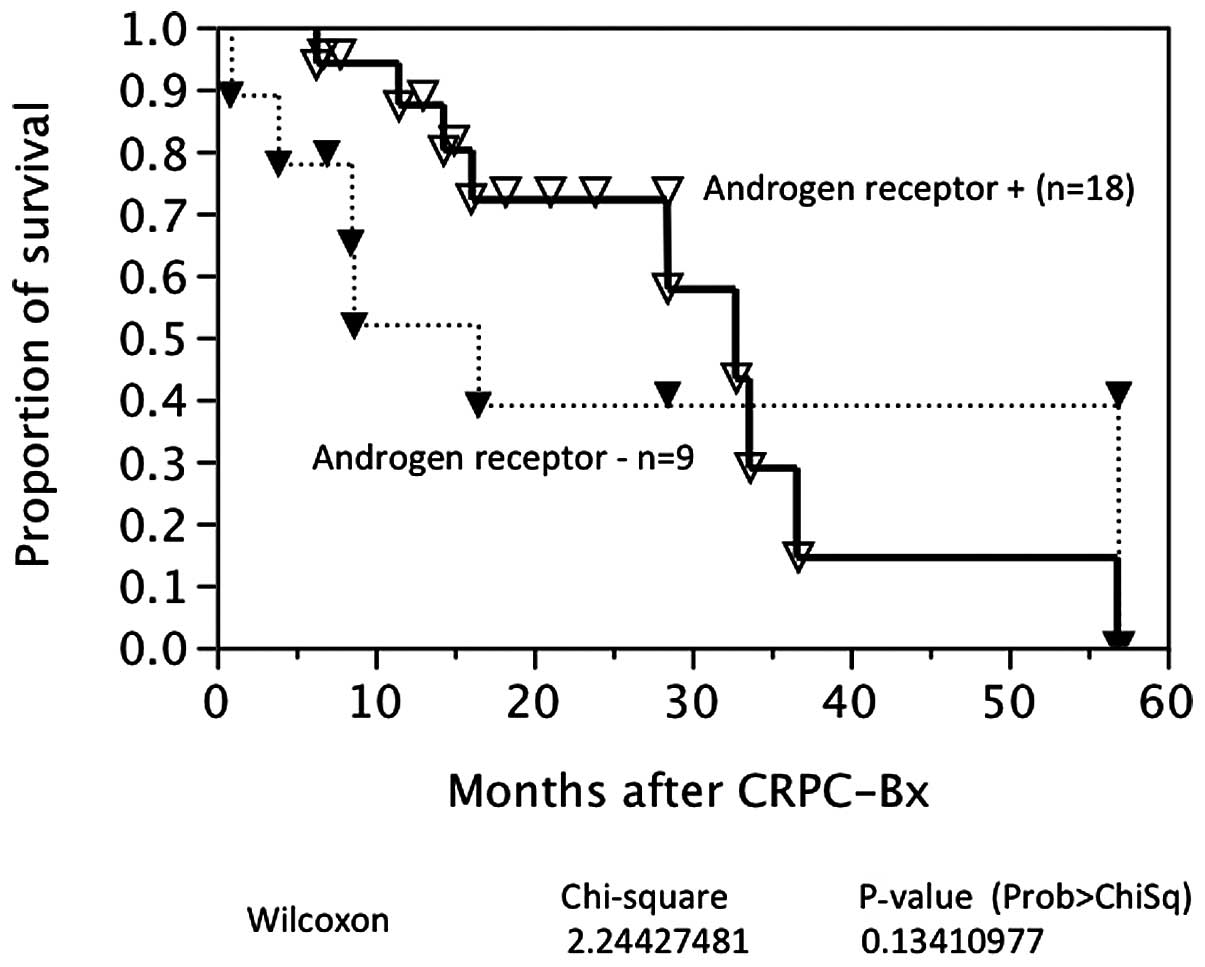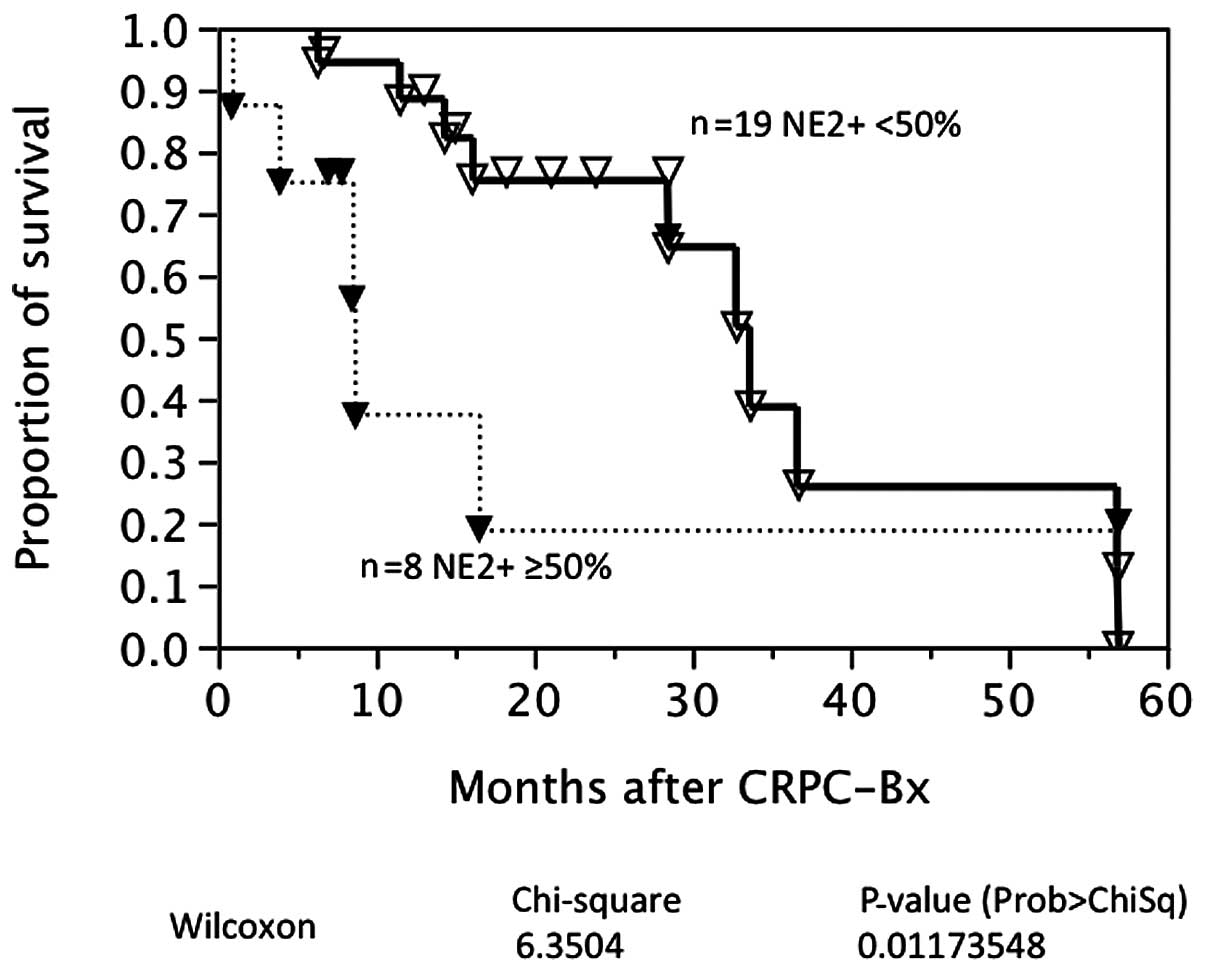|
1
|
Suzuki H, Komiya A, Kamiya N, Imamoto T,
Kawamura K, Miura J, Suzuki N, Nakatsu H, Hata A and Ichikawa T:
Development of a nomogram to predict probability of positive
initial prostate biopsy among Japanese patients. Urology.
67:131–136. 2006. View Article : Google Scholar : PubMed/NCBI
|
|
2
|
Yano M, Imamoto T, Suzuki H, Fukasawa S,
Kojima S, Komiya A, Naya Y and Ichikawa T: The clinical potential
of pretreatment serum testosterone level to improve the efficiency
of prostate cancer screening. Eur Urol. 51:375–380. 2007.
View Article : Google Scholar
|
|
3
|
Scher HI, Halabi S, Tannock I, Morris M,
Sternberg CN, Carducci MA, Eisenberger MA, Higano C, Bubley GJ,
Dreicer R, Petrylak D, Kantoff P, Basch E, Kelly WK, Figg WD, Small
EJ, Beer TM, Wilding G, Martin A and Hussain M; Prostate Cancer
Clinical Trials Working Group: Design and end points of clinical
trials for patients with progressive prostate cancer and castrate
levels of testosterone: recommendations of the Prostate Cancer
Clinical Trials Working Group. J Clin Oncol. 26:1148–1159. 2008.
View Article : Google Scholar
|
|
4
|
Scher HI, Buchanan G, Gerald W, Butler LM
and Tilley WD: Targeting the androgen receptor: improving outcomes
for castration-resistant prostate cancer. Endocr Relat Cancer.
11:459–476. 2004. View Article : Google Scholar : PubMed/NCBI
|
|
5
|
Attar RM, Takimoto CH and Gottardis MM:
Castration-resistant prostate cancer: locking-up the molecular
escape routes. Clin Cancer Res. 15:3251–3255. 2009. View Article : Google Scholar : PubMed/NCBI
|
|
6
|
De Bono JS, Logothetis CJ, Molina A,
Fizazi K, North S, Chu L, Chi KN, Jones RJ, Goodman OB Jr, Saad F,
Staffurth JN, Mainwaring P, Harland S, Flaig TW, Hutson TE, Cheng
T, Patterson H, Hainsworth JD, Ryan CJ, Sternberg CN, Ellard SL,
Fléchon A, Saleh M, Scholz M, Efstathiou E, Zivi A, Bianchini D,
Loriot Y, Chieffo N, Kheoh T, Haqq CM and Scher HI; COU-AA-301
Investigators: Abiraterone and increased survival in metastatic
prostate cancer. N Engl J Med. 364:1995–2005. 2011.
|
|
7
|
Tran C, Ouk S, Clegg NJ, Chen Y, Watson
PA, Arora V, Wongvipat J, Smith-Jones PM, Yoo D, Kwon A,
Wasielewska T, Welsbie D, Chen CD, Higano CS, Beer TM, Hung DT,
Scher HI, Jung ME and Sawyers CL: Development of a
second-generation antiandrogen for treatment of advanced prostate
cancer. Science. 324:787–790. 2009. View Article : Google Scholar
|
|
8
|
Scher HI, Fizazi K, Saad F, Taplin ME,
Sternberg CN, Miller MD, de Wit R, Mulders P, Chi KN, Shore ND,
Armstrong AJ, Flaig TW, Fléchon A, Mainwaring P, Fleming M,
Hainsworth JD, Hirmand M, Selby B, Seely L and de Bono JS; AFFIRM
Investigators: Increased survival with enzalutamide in prostate
cancer after chemotherapy. N Engl J Med. 367:1187–1197. 2012.
View Article : Google Scholar : PubMed/NCBI
|
|
9
|
Komiya A, Suzuki H, Imamoto T, Kamiya N,
Nihei N, Naya Y, Ichikawa T and Fuse H: Neuroendocrine
differentiation in the progression of prostate cancer. Int J Urol.
16:37–44. 2009. View Article : Google Scholar : PubMed/NCBI
|
|
10
|
Tanaka M, Suzuki Y, Takaoka K, Suzuki N,
Murakami S, Matsuzaki O and Shimazaki J: Progression of prostate
cancer to neuroendocrine cell tumor. Int J Urol. 8:431–436. 2001.
View Article : Google Scholar : PubMed/NCBI
|
|
11
|
Grossmann ME, Huang H and Tindall DJ:
Androgen receptor signaling in androgen-refractory prostate cancer.
J Natl Cancer Inst. 93:1687–1697. 2001. View Article : Google Scholar : PubMed/NCBI
|
|
12
|
Zegarra-Moro OL, Schmidt LJ, Huang H and
Tindall DJ: Disruption of androgen receptor function inhibits
proliferation of androgen-refractory prostate cancer cells. Cancer
Res. 62:1008–1013. 2002.PubMed/NCBI
|
|
13
|
Chen CD, Welsbie DS, Tran C, Baek SH, Chen
R, Vessella R, Rosenfeld MG and Sawyers CL: Molecular determinants
of resistance to antiandrogen therapy. Nat Med. 10:33–39. 2004.
View Article : Google Scholar : PubMed/NCBI
|
|
14
|
Crook JM, O’Callaghan CJ, Duncan G,
Dearnaley DP, Higano CS, Horwitz EM, Frymire E, Malone S, Chin J,
Nabid A, Warde P, Corbett T, Angyalfi S, Goldenberg SL,
Gospodarowicz MK, Saad F, Logue JP, Hall E, Schellhammer PF, Ding K
and Klotz L: Intermittent androgen suppression for rising PSA level
after radiotherapy. N Engl J Med. 367:895–903. 2012. View Article : Google Scholar : PubMed/NCBI
|
|
15
|
Nagata T, Shimada Y, Sekine S, Hori R,
Matsui K, Okumura T, Sawada S, Fukuoka J and Tsukada K: Prognostic
significance of NANOG and KLF4 for breast cancer. Breast Cancer.
Apr 17–2012.(Epub ahead of print).
|
|
16
|
Bonkhoff H and Berges R: From pathogenesis
to prevention of castration resistant prostate cancer. Prostate.
70:100–112. 2010. View Article : Google Scholar : PubMed/NCBI
|
|
17
|
Hobisch A, Culig Z, Radmayr C, Bartsch G,
Klocker H and Hittmair A: Distant metastases from prostatic
carcinoma express androgen receptor protein. Cancer Res.
55:3068–3072. 1995.PubMed/NCBI
|
|
18
|
Shah RB, Mehra R, Chinnaiyan AM, Shen R,
Ghosh D, Zhou M, Macvicar GR, Varambally S, Harwood J, Bismar TA,
Kim R, Rubin MA and Pienta KJ: Androgen-independent prostate cancer
is a heterogeneous group of diseases: lessons from a rapid autopsy
program. Cancer Res. 64:9209–9216. 2004. View Article : Google Scholar : PubMed/NCBI
|
|
19
|
Takeda H, Akakura K, Masai M, Akimoto S,
Yatani R and Shimazaki J: Androgen receptor content of prostate
carcinoma cells estimated by immunohistochemistry is related to
prognosis of patients with stage D2 prostate carcinoma. Cancer.
77:934–940. 1996. View Article : Google Scholar : PubMed/NCBI
|
|
20
|
Masai M, Sumiya H, Akimoto S, Yatani R,
Chang CS, Liao SS and Shimazaki J: Immunohistochemical study of
androgen receptor in benign hyperplastic and cancerous human
prostates. Prostate. 17:293–300. 1990. View Article : Google Scholar : PubMed/NCBI
|
|
21
|
Matei DV, Renne G, Pimentel M, Sandri MT,
Zorzino L, Botteri E, De Cicco C, Musi G, Brescia A, Mazzoleni F,
Tringali V, Detti S and de Cobelli O: Neuroendocrine
differentiation in castration-resistant prostate cancer: a
systematic diagnostic attempt. Clin Genitourin Cancer. 10:164–173.
2012. View Article : Google Scholar : PubMed/NCBI
|
|
22
|
McWilliam LJ, Manson C and George NJ:
Neuroendocrine differentiation and prognosis in prostatic
adenocarcinoma. Br J Urol. 80:287–290. 1997. View Article : Google Scholar : PubMed/NCBI
|
|
23
|
Kokubo H, Yamada Y, Nishio Y, Fukatsu H,
Honda N, Nakagawa A, Saga S, Tsuzuki T and Hara K:
Immunohistochemical study of chromogranin A in Stage D2 prostate
cancer. Urology. 66:135–140. 2005. View Article : Google Scholar : PubMed/NCBI
|
|
24
|
Kamiya N, Suzuki H, Kawamura K, Imamoto T,
Naya Y, Tochigi N, Kakuta Y, Yamaguchi K, Ishikura H and Ichikawa
T: Neuroendocrine differentiation in stage D2 prostate cancers. Int
J Urol. 15:423–428. 2008. View Article : Google Scholar : PubMed/NCBI
|
|
25
|
Mucci NR, Akdas G, Manely S and Rubin MA:
Neuroendocrine expression in metastatic prostate cancer: evaluation
of high throughput tissue microarrays to detect heterogeneous
protein expression. Hum Pathol. 31:406–414. 2000. View Article : Google Scholar
|
|
26
|
Amato RJ, Logothetis CJ, Hallinan R, Ro
JY, Sella A and Dexeus FH: Chemotherapy for small cell carcinoma of
prostatic origin. J Urol. 147:935–937. 1992.PubMed/NCBI
|
|
27
|
Komiya A, Yasuda K, Nozaki T, Fujiuchi Y,
Hayashi S and Fuse H: Small cell carcinoma of the prostate after
high-dose-rate brachytherapy for low-risk prostatic adenocarcinoma.
Oncol Lett. 5:53–56. 2013.PubMed/NCBI
|
|
28
|
Rizzardi AE, Johnson AT, Vogel RI,
Pambuccian SE, Henriksen J, Skubitz AP, Metzger GJ and Schmechel
SC: Quantitative comparison of immunohistochemical staining
measured by digital image analysis versus pathologist visual
scoring. Diagn Pathol. 7:422012. View Article : Google Scholar
|

















